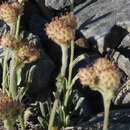Comments
(
Inglês
)
fornecido por eFloras
The Antennaria friesiana complex consists of subsp. alaskana, subsp. neoalaskana, and subsp. friesiana, the former two are dioecious (sexual) phases of the latter gynoecious (asexual) form. The sexual populations are known from Alaska and cordilleran areas of northern Yukon and adjacent Northwest Territories (R. J. Bayer 1991). The apomictic phase is almost circumpolar, occurring from the central and eastern Siberian plateau eastward across the North American arctic to Greenland (Bayer). E. Hultén (1968) circumscribed a fourth subspecies, A. friesiana subsp. compacta. After studying its morphology, in the field and herbarium, it is apparent that Hultén’s taxon contains at least three incongruous entities that are probably not at all related to the other two subspecies of A. friesiana. Hultén’s subsp. compacta included A. densifolia, which is recognized as a distinct species, and A. crymophila and A. neoalaskana as taxonomic synonyms. Antennaria compacta in the strict sense and A. crymophila are perhaps hybrid apomicts and are treated here in A. alpina (see Bayer for details). Antennaria neoalaskana is treated here as a subspecies of A. friesiana.
- licença
- cc-by-nc-sa-3.0
- direitos autorais
- Missouri Botanical Garden, 4344 Shaw Boulevard, St. Louis, MO, 63110 USA
Description
(
Inglês
)
fornecido por eFloras
Dioecious or gynoecious (staminate plants uncommon or in equal frequencies to pistillates, respectively). Plants 7–15 cm (stems stipitate-glandular, hairs purple). Stolons 0.1–4 cm. Basal leaves 1-nerved, narrowly spatulate to oblanceolate, 11–30 × 2–4 mm, tips mucronate, abaxial faces tomentose, adaxial green-glabrescent to gray-pubescent. Cauline leaves linear, 4–20 mm, flagged. Heads 2–6 in corymbiform arrays. Involucres: staminate 4–6.5 mm; pistillate 5.5–8 mm. Phyllaries distally usually black, light brown, dark brown, or olivaceous, sometimes. Corollas: staminate 2.5–3 mm; pistillate 3–4.5 mm. Cypselae 1.2–2 mm, glabrous or slightly papillate; pappi: staminate 3–4 mm; pistillate 3.5–5 mm. 2n = 28, 56, 63, 100+.
- licença
- cc-by-nc-sa-3.0
- direitos autorais
- Missouri Botanical Garden, 4344 Shaw Boulevard, St. Louis, MO, 63110 USA
Synonym
(
Inglês
)
fornecido por eFloras
Antennaria alpina (Linnaeus) Gaertner var. friesiana Trautvetter, Trudy Imp. S.-Petersburgsk. Bot. Sada 6: 24. 1879
- licença
- cc-by-nc-sa-3.0
- direitos autorais
- Missouri Botanical Garden, 4344 Shaw Boulevard, St. Louis, MO, 63110 USA
Antennaria friesiana
(
Inglês
)
fornecido por wikipedia EN
Antennaria friesiana, or Fries' pussytoes, is an Arctic species of plants in the family Asteraceae. It is the northern reaches of Asia and North America (Russia, Alaska, Northwest Territories, Yukon, Nunavut, Quebec, Labrador, and Greenland). Many of the populations lack male (staminate) flowers and reproduce asexually.[2][3][4][5]
- Subspecies[1][2]
Classification of this and related species is still a subject of discussion, but The Plant List maintained by Kew Botanic Gardens in London recognizes four subspecies:
References

- licença
- cc-by-sa-3.0
- direitos autorais
- Wikipedia authors and editors
Antennaria friesiana: Brief Summary
(
Inglês
)
fornecido por wikipedia EN
Antennaria friesiana, or Fries' pussytoes, is an Arctic species of plants in the family Asteraceae. It is the northern reaches of Asia and North America (Russia, Alaska, Northwest Territories, Yukon, Nunavut, Quebec, Labrador, and Greenland). Many of the populations lack male (staminate) flowers and reproduce asexually.
Subspecies
Classification of this and related species is still a subject of discussion, but The Plant List maintained by Kew Botanic Gardens in London recognizes four subspecies:
Antennaria friesiana subsp. alaskana (Malte) Hultén –
Alaska,
Yukon,
Northwest Territories Antennaria friesiana subsp. beringensis V.V.Petrovsky –
Russian Far East Antennaria friesiana subsp. friesiana – most of species range Antennaria friesiana subsp. neoalaskana (A.E.Porsild) R.J.Bayer & Stebbins –
Brooks Range in
Alaska;
Richardson Mountains +
MacKenzie Mountains in
Canada
- licença
- cc-by-sa-3.0
- direitos autorais
- Wikipedia authors and editors

